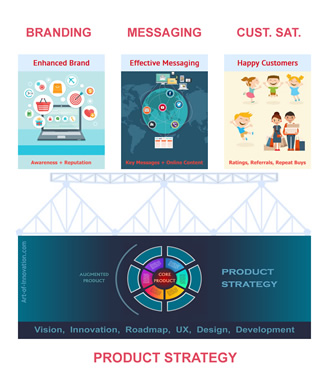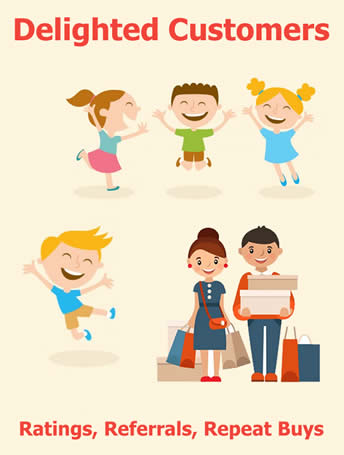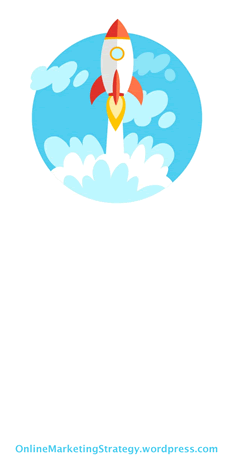 Let’s take a look at the ultimate driver of business success – growing numbers of satisfied customers. This is one of the four key pillars of business success and growth – as outlined on our home page Online Marketing Strategy 101.
Let’s take a look at the ultimate driver of business success – growing numbers of satisfied customers. This is one of the four key pillars of business success and growth – as outlined on our home page Online Marketing Strategy 101.
The key is to raise key questions, look at things from first principles, apply sound concepts (summarized below).
Great benefits / ROI / payoffs result from addressing each of these strategic focus areas.
Let’s take a closer look at:
- the “why and what” of customer delight
- the “how” of achieving greater customer focus & understanding.
1. Understanding and applying the power of Customer Delight
Why is customer satisfaction and delight important?
How is ongoing innovation related to customer enthusiasm?
How do you develop a base of happy & loyal customers?
Part 1

Delighted Customers
- High ratings + likes
- Positive reviews
- Ongoing referrals
- Repeat visits & buys
- Valuable feedback
The ultimate goal
It’s simple – are you creating happy customers? And in greater numbers?
The true measure of a successful and growing business is the delivered value, need satisfaction, and overall positive experience felt by your growing body of customers.
It is the only sustainable & ethical way to grow your business towards large scale adoption and success.
The critical metric
A lot of companies view the sale as the cherished goal of a marketing and sales process. Smart companies – the thin slice of successful businesses that keep growing & thriving for years – look at repeat business, referrals, positive reviews as the true signs of delivering real value to their targeted customer segments.
It requires an enlightened mindset to view and value the customer relationship, rather than having sales transaction focus.
And, to seek & apply long-term, sustainable success factors rather than short-term tactics & gimmicks!
Strategy that works
Successful companies go beyond the usual efforts (such as monitoring feedback from site visits or purchases) to really understand their target audience’s core needs, goals, and preferences – as well as their situation (operating environment and processes).
Armed with these consumer insights, they drive their product innovation and business model evolution efforts – aiming to satisfy the expectations of their current customers and attract new segments.
The whole picture
A common mistake is to over-emphasize product features and benefits while ignoring the concept of the whole or augmented product – where all supporting processes (e.g. buying or support process) and related aspects (e.g. a warranty) are recognized for their impact on customer satisfaction.
Initial purchase satisfaction (commonly measured soon after the sale) can distract marketing teams from the real goal of ensuring the customers full and ongoing use of your product / service.

Ongoing product innovation
As the millennia-old wine industry and the century-old car industry show us, people like new varieties in new formats – even if some core things remain the same – like 4 wheels and the need to go places!
Attracting and delighting customers with new and improved ways to deliver great benefits & value is the best way to achieve solid & sustained growth i.e. a customer-focused product innovation strategy.
Hoping to win happy customers while not adequately working on product strategy is wishful thinking. Regardless of the examples set by some Silicon Valley players(!), that approach hits a limit before long!
Thus, the smart, long-range strategy is a genuine focus on developing and delivering well designed, high quality products and services (whether inexpensive or high-end offerings). Which are supported by strategy-driven, high quality marketing communications.
Another key driver
Customer-focused innovation is also the best way to stay ahead of your competition. Regardless of the nature of your product, competition is getting more intense in every industry – with global trends such as:
- unleashing of entrepreneurial energy and skills worldwide
- the ease of finding alternative products and companies via online shopping
- the evolution of scalable technologies in manufacturing and IT.
So, if you are not focusing on anticipating, envisioning, and satisfying the validated needs of your customers, someone else will – and earn their dollars and approval / referrals!
Strategic marketing
Given the above, smart businesses are continually investing in strategic marketing to better understand their customers needs & market trends, improve their current offerings, and develop new, innovative products. It is the only sustainable way to keep your customers satisfied and your competitors at bay – making it a worthwhile investment with a high ROI.
Given the tremendous hype and luring promise of tactical marketing, it is good to see & remember that no bag of promotion tricks has been able to mitigate the drawback of an inferior product!
It takes visionary leadership, courage, and smart execution (make-it-happen) skills to pursue a customer-needs driven innovation strategy. And people over the ages have appreciated, admired and rewarded those qualities – and the associated people, organizations, products!
Additional concepts
In the section below, Customer Focus, view a summary of powerful ideas that help you develop the deeper understanding of customers.
Getting there
The pursuit of the goals and outcomes outlined here is the domain where strategic product management truly makes a difference.
It is not about formal processes or large budgets. It is about having the strategic / big-picture mindset to see things in a wider perspective, sharp analysis to evaluate key drivers and trends for insights, intelligently anticipating the evolution of user needs, and creatively envisioning new solutions and opportunities.
With the right emphasis, skills, and investments, strategy-driven product management delivers great results and extraordinarily high returns.

Online Marketing Strategy 101
Get started today
Part 2:
Customer Focus Strategy – Additional Concepts
How to deepen your understanding of customer segments/sub-groups?
Applying insights from the Product Life Cycle and Innovation Adoption curves
Understanding customer needs + priorities at each step of the Buying Process
Tailoring communications and influence strategies based on Buyer Roles
Part 2

Customer FOCUS
- Customer types
- Adoption stages
- Buying process
- Buyer roles
- B2B / B2C markets
The S-Curve of customer growth
The S-shaped curve that shows the increasing number of customers as they progressively adopt your new or upgraded product – has stood the test of time.
Also called the product life cycle curve or the innovation diffusion curve, it offers some insights and guidance to those planning to hike the sigmoid slope!
The sequence of customers, from the launch of the product to its eventual saturation point / plateau level, are put into the following groups – innovators (2.5%), early adopters (13.5%), early majority (34%), late majority (34%), laggards (16%).

It is important to recognize the differences across these groups – looking deeper to understand their attributes, locations, preferences, beliefs, and behaviors.
In other words, their demographic, geographic, psychographic, behavioral profiles.
Only by tailoring your product (versions), communications, and channels to these customer subsets, you will get a chance to grow from one subset to another different and larger set.
Viewing your targeted and actual growth (forecasts and results) against the backdrop of this s-curve concept, will help you anticipate and strategize to keep you moving forward.
Market & customer types
Depending on the nature of your product, you sales and marketing efforts will generally fall into the B2B (business-to-business) or B2C (business-to-consumer) market. While there are underlying similarities, there are significant differences in the steps and roles involved in the buying process.
In addition, there are other major differences such as order quantity, frequency, network buying, budgets, price-sensitivity, quality / reliability / serviceability requirements, buying process duration, and seasonality. Anticipating and leveraging these aspects can strengthen your marketing strategy and plans.

Buying process
You can greatly increase your marketing effectiveness by tailoring communication materials (marcom content) and actual marketing communications (channel, frequency) based on a good knowledge of the buying steps that apply to your product / market.
Key steps of the buying process:
- awareness
- interest
- trial
- evaluation
- desire and decision
- purchase
- usage
- review and referral
- repeat purchase
Conventional marketing wisdom says that consumer purchases are more impulse driven while purchasing managers at a business follow a more structured and rigorous evaluation process. Obviously, the nature and price of the product (e.g. a house, car, or expensive home electronics vs. a coffee maker) – as well as buyer personality – can tilt things in the other direction!
These buying steps also fit in nicely with the concept of a sales funnel, with potential customers being guided carefully through all the key steps. Helping them become highly satisfied customers who rave about your product (customer advocacy.)
Buyer Roles
As with the variations in buying steps in the B2B and B2C environments, the concept of buyer roles applies to both, but with some differences. The roles may be less formal or distinct in the B2C market, but it pays off to appreciate each role – and their influence on the buying process steps outlined above.
- User Buyer
- Technical Buyer
- Economic Buyer
- Coach
For example, for a toy or PC purchase, the child would be the user buyer, one parent could take on the task of technical evaluation (specs, quality) , while the other could be the price shopper / economic buyer deciding on an acceptable price and making the payment.
Customer focus ROI
For a summary of the benefits of focusing on customer needs – and prioritizing them to drive your product innovation and marketing communications – take a look at part 1 of this page – Customer Delight.
Making it happen
Putting a customer focused strategy in place can go from being just a slogan to a way of doing business when you incorporate insightful and powerful concepts like the ones outlined above.
Understanding your customers, sub-groups, their buying process, and buyer roles helps you refine several key aspects of your marketing strategy – from product innovation, differentiation, to marketing communications. .
Regardless of the scale of your company (SMB to large corporation) or your budgets, the power of game-changing ideas helps to raise the level of your game – positioning you for a higher level of success!

Online Marketing Strategy 101
Get started today
Working with an innovation-driven, sharp marketing strategy consultant can help you get ahead in these core priority areas – propelling your business towards near-term and long-term business and marketing goals.
Contact us today to set up an initial call to discuss your business goals & marketing needs – and how we can help you achieve them.
View these additional key elements of Marketing Strategy
NEXT SECTION
How to assess your market and competitive challenges — to glean strategic insights and opportunities for innovation and growth
Once we see the impact of these strategic and core marketing goals, we can take a look at the best ways to get there.
Once we appreciate the power and impact of these core strategic dimensions of a successful marketing plan, we can start examining the best ways to build a solid foundation.
The Strategic Marketing Analysis page presents a succinct overview of the four main types of marketing analysis. These quick summaries from a high level perspective clarify how these four marketing analysis efforts can help you build a solid overall marketing strategy. The Strategic Marketing Analysis page summarizes the key challenges within each area, along with the great rewards / payoffs.
Drop me a line when you are ready to partner with a sharp, creative thinker, an experienced marketing strategist, an objective sounding board, to enrich your company’s brand / image; messaging / communications; and product development / product innovation efforts.
- Big-4 Management Consulting firm experience
- Fortune 500 and other leading global corporations
- As well as SMB, small business, entrepreneurial startups.

© 2016-17 Auri Biswas. All rights reserved.


